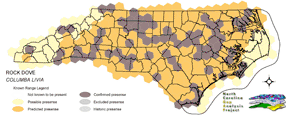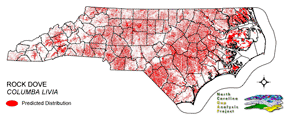
| Taxa: |
| Order: |
| Family: |
| Aves |
| Columbiformes |
| Columbidae |
| NatureServe Global Rank: |
| NatureServe State (NC) Rank: |
| G5 |
| SE |
| Federal Status: |
| NC State Status: |
| --- |
| --- |


| Land Unit |
| US Fish & Wildlife Service |
| US Forest Service |
| US National Park Service |
| US Department of Defense |
| NC State Parks |
| NC University System |
| NC Wildlife Res. Com. |
| NC Forest Service |
| NC Div. of Coastal Mgmt. |
| Local Governments |
| Non-Governmental Org. |
| Other Public Lands |
| Private Lands |
| GAP Status 1-2 |
| All Protected Lands |
| Statewide |
| Hectares |
| 7,331.94 |
| 9,951.75 |
| 16,156.26 |
| 7,175.52 |
| 2,219.13 |
| 1,214.37 |
| 4,943.97 |
| 975.87 |
| 449.91 |
| 648.54 |
| 1,628.55 |
| 2,462.85 |
| 3,913,382.07 |
| 18,438.39 |
| 53,790.93 |
| 3,968,540.73 |
| Acres |
| 18,117.61 |
| 24,591.31 |
| 39,922.98 |
| 17,731.09 |
| 5,483.59 |
| 3,000.77 |
| 12,216.81 |
| 2,684.08 |
| 1,111.75 |
| 1,602.58 |
| 4,024.23 |
| 6,085.83 |
| 9,670,175.81 |
| 45,834.90 |
| 133,192.91 |
| 9,806,748.46 |
| % of Dist. on |
| Prot. Lands |
| 13.6 % |
| 18.5 % |
| 29.8 % |
| 13.3 % |
| 4.1 % |
| 2.3 % |
| 8.2 % |
| 1.8 % |
| 0.8 % |
| 2.9 % |
| 2.9 % |
| 3.4 % |
| < 0.1 % |
| 34.3 % |
| ----- |
| ----- |
| % of Dist. on |
| All Lands |
| 0.2 % |
| 0.3 % |
| 0.4 % |
| 0.2 % |
| < 0.1 % |
| < 0.1 % |
| 0.1 % |
| < 0.1 % |
| < 0.1 % |
| < 0.1 % |
| < 0.1 % |
| < 0.1 % |
| 98.6 % |
| 0.5 % |
| ----- |
| ----- |
|
Introduced. Common in 'all but the most remote regions' and the high elevations of the mountains (Potter et al. 1980, Simpson 1992). Nests gregariously on ledges and manmade structures of various types within one kilometer of foraging areas in open country with short vegetation such as parks, yards, pastures, plowed fields, and farmyards. In cities, rely heavily on human food sources and thus consume a great deal of bread and other scraps (Goodwin 1983, Nicholson 1997). Always found near human habitation (Ehrlich et al. 1988). Rarely nests on its ancestral habitat of cliffs, but rather nests primarily on man-made structures such as barns, buildings, bridges (Nicholson 1997), holes, or wells. Prefers a nest site located in semi-darkness. Will also occasionally nest in the crotch of a tree (Goodwin 1983). NATURE SERVE GLOBAL HABITAT COMMENTS: In wild state along rocky seacoasts or inland in gorges, river valleys, caves, and desert oases. Feral birds occasionally in natural habitats, more abundantly near human settlement, espec. in cities and around farms. REPRODUCTIVE HABITAT COMMENTS: Nests in cliff ledges, caves, building ledges, bridge structures, monuments, abandoned houses and barns, and in palm trees (e.g., West Indies). |
| Code | Name | Description | NC Natural Heritage Program Equivalent |
| 378 | Ocean Beaches | Open beach sand. | Upper Beach |
| 371 | Maritime Grasslands | Dune grass community consisting of sea oats and beach grasses. | Dune grass, Maritime dry grassland |
| 180 | Agricultural Crop Fields | Farm fields used for row crops. | No equivalent |
| 205 | Agricultural Pasture/Hay and Natural Herbaceous | Farm fields used for pasture grass or hay production, as well as old fields dominated by native and exotic grasses. | No equivalent |
| 202 | Residential Urban | Includes vegetation interspersed in residential areas. Includes lawns, mixed species woodlots, and horticultural shrubs. Vegetation accounts for between 20 - 70% of the cover. | No equivalent |
| 203 | Urban Low-Intensity Developed | Highly developed areas with vegetation accounting for < 20% of the cover. | No equivalent |
| 204 | Urban High-Intensity Developed and Transportation Corridors | Highly developed areas including infrastructure such as roads, railroads. Vegetation represents < 20% of the cover. | No equivalent |
| 535 | Talus/Outcrops/Cliffs | Includes seep talus slopes with sparce vegetation, as well as outcrops including, granitic outcrops. Some outcrops will have been mapped as barren rock. | No equivalent |
|
Banks, R. C., and M. R. Browning. 1995. Comments on the status of revived old names for some North American birds. Auk 112:633-648.
Simpson MB Jr. 1992. Birds of the Blue Ridge Mountains. Chapel Hill and London: University of North Carolina Press. Nicholson CP. 1997. Atlas of the breeding birds of Tennessee. Knoxville: University of Tennessee Press. Johnston, R. F., and S. G. Johnson. 1990. Reproductive ecology of feral pigeons. Pages 237-252 in J. Pinowski and J. D. Summers-Smith, editors. Granivorous birds in the agricultural landscape. Polish Scientific Publisher, Warszawa. 360 pp. Harrison, C. 1978. A field guide to the nests, eggs and nestlings of North American birds. Collins, Cleveland, Ohio. Harrison, H.H. 1979. A field guide to western birds' nests. Houghton Mifflin Company, Boston. 279 pp. Potter, E. F., J. F. Parnell, and R. P. Teulings. 1980. Birds of the Carolinas. Univ. North Carolina Press, Chapel Hill. 408 pp. Terres, J.K. 1980. The Audubon Society encyclopedia of North American birds. Alfred A. Knopf, New York. American Ornithologists' Union (AOU), Committee on Classification and Nomenclature. 1983. Check-list of North American Birds. Sixth Edition. American Ornithologists' Union, Allen Press, Inc., Lawrence, Kansas. Goodwin, D. 1983. Pigeons and doves of the world. Third edition. British Museum (Natural History), London, and Cornell Univ. Press, Ithaca. 363 pp. [496 pp.?]. Ehrlich, P.R., D.S. Dobkin, and D. Wheye. 1988. The birder's handbook:a field guide to the natural history of North American birds. Simon and Shuster, Inc., New York. xxx + 785 pp. Droege, S., and J.R. Sauer. 1990. North American Breeding Bird Survey, annual summary, 1989. U.S. Fish and Wildlife Service, Biological Report 90(8). 22 pp. Tansey, M. F., and R. P. Roth. 1970. Pigeons, a new role in air pollution. J. Air Pollution Control Assoc. 20:307-309. |
For more information please contact them at:
NC-GAP Analysis Project
Dept. of Zoology, NCSU
Campus Box 7617
Raleigh, NC 27695-7617
(919) 513-2853
www.basic.ncsu.edu/ncgap